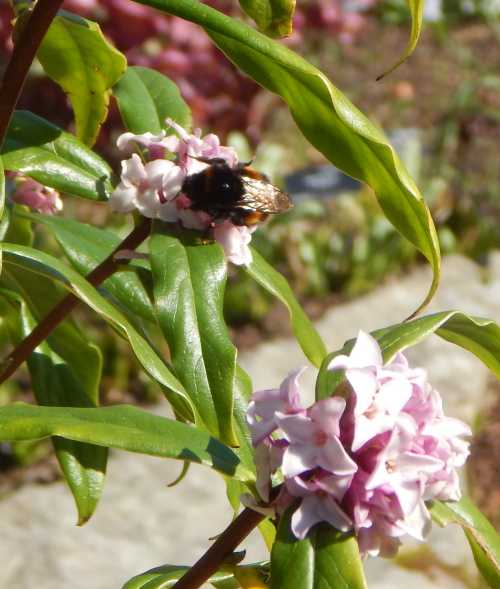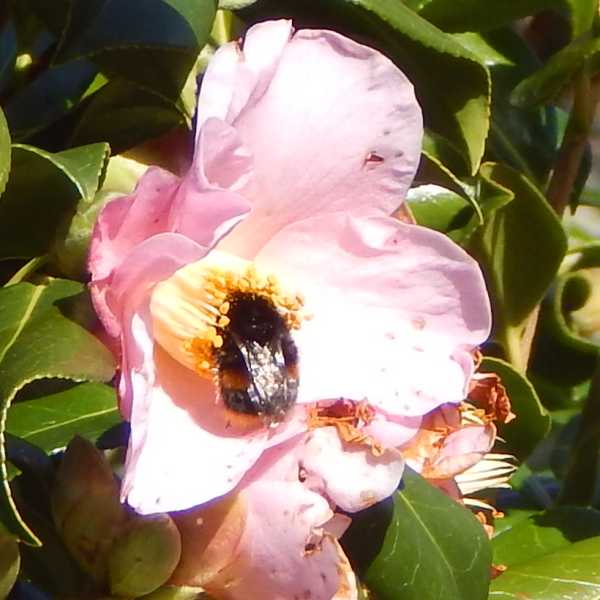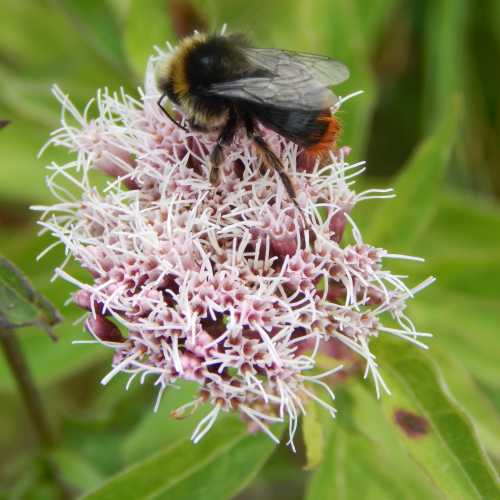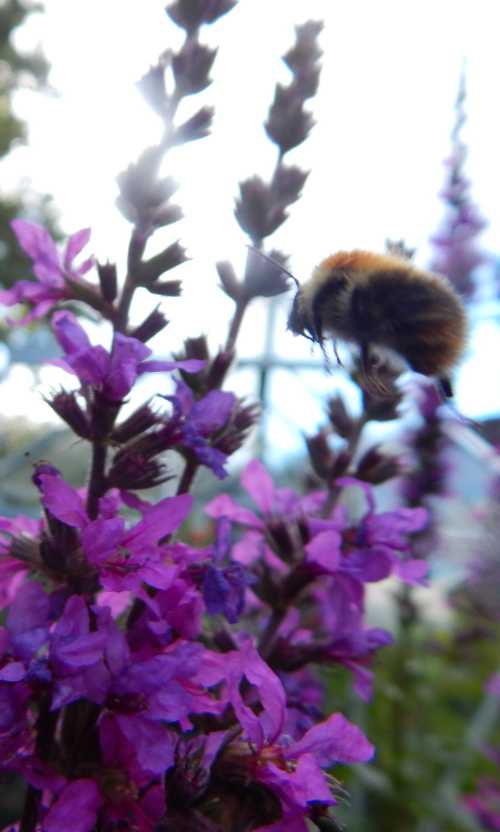Can Bumble Bees Survive Cold Temperatures?
Updated: November 2023
Questions:
"It's very cold, and I have found a bumble bee. It's not moving. Will it be survive?"
"Can bumble bees survive cold weather?"
The short answer is:
Scientists have found that buff tailed bumble bees (Bombus terrestris audax) workers could freeze at temperatures of -7.1°C, whilst queens would freeze at about −7.4 °C.
There may be some similarities with other bumble bee species. Thus, if temperatures drop to that level, they are less likely to survive. Here we look at the research, and how to help bees in cool temperatures.
Survival Of Winter Active Bumble Bees In Cold Temperatures
 This stunning and exquisitely fragrant winter flowering shrub Daphne bholua 'Jacqueline Postill' is popular with bumble bee queens and honey bees in winter. I have even seen Comma butterflies foraging on during cold weather.
This stunning and exquisitely fragrant winter flowering shrub Daphne bholua 'Jacqueline Postill' is popular with bumble bee queens and honey bees in winter. I have even seen Comma butterflies foraging on during cold weather.At the time of writing, the weather is typically hitting about 15°C, a temperature fine for bumble bees. However, during the winter every year, I am asked whether bumble bees can survive in very cold conditions.
This query usually arises from people who have found an inactive queen bumble bee. People become concerned about whether the bee will survive or will it die from exposure to the cold. They are often wondering what they can do to help the bee.
The question of the survival of bees in cool temperatures has been the subject of published research in 2013 by Owen et al1, a team of scientists who were primarily pondering this topic. They wrote:
" ...it is crucial to determine whether key pollinator species such as bumblebees will actually benefit from climate change, or if winter activity might have a negative impact on their abundance, distribution and pollination service provision."
Owen et al Scientific Research Summary
Owen et al studied cool temperature tolerance of Bombus terrestris audax (buff tailed bumble bee), one of the earliest species of bumble bee to emerge from winter hibernation in the UK.
Other bumble bee species may respond in a similar way to cool temperatures, but differences could also occur.
Note: The temperature at which bees (and other arthropods) freeze is called the super cooling point (SPC).
Several key points from the research:
- Bombus terrestris audax workers could freeze at temperatures of -7.1°C (the SPC), whilst queens would freeze at about −7.4 °C (SPC).
- Queens were able to tolerate cool temperatures for longer than workers, probably due to having greater fat reserves.
- Despite this, both workers and queens were able to tolerate cool temperatures for short periods. For example, about 80% of the samples survived after exposure to −5°C for 2 hours.
- The researchers note that bumble bees spending a night away from the warmth of the colony and nest, could be at risk in cool temperatures. Temperatures have been known to dip as low as −10°C in the UK.
- The researchers also commented on the risk of chronic low colony temperatures. While bumble bees do possess the ability to thermoregulate their colonies, a lack of winter floral resources or an excessive thermoregulatory demand, may mean colonies are unable to consistently maintain a favourable temperature.
In the case of Bombus terrestris audax which typically construct nests underground at a range of depths, winter soil temperatures (10 cm depth) in the UK have been known to consistently fall below 5°C for many weeks, and below 0°C for periods of several days, even in the warmer, southern parts of England. - Low day time temperatures when bees need to forage for food, could decrease the survival chances of bees.
Do all bee species have the same temperature tolerance levels?
Actually, no! For example, solitary mason bee species Osmia cornuta and Osmia rufa, are both hardier with SCPs typically below −24°C.
However, I have received queries from concerned readers who have discovered dead mason bees in cold temperatures.
Helping bees to survive cold temperatures
 Plant winter flowering shrubs for bees, such as camellia.
Plant winter flowering shrubs for bees, such as camellia.The most important thing you can do for the longer term, is provide winter flowering shrubs and plants for bees.
There are many choices available, from low-growing, hardy heathers that are versatile in the garden or in pots, to attractive shrubs, such as Daphne.
This will enable bees foraging in cool temperatures, to help sustain them.
Bulbs such as crocus are also invaluable.
Read about winter flower borders.
Finding an immobile bee
I receive many emails from worried members of the public about finding bumble bees that are exposed to the cold, and apparently not moving.
Queens sometimes remain stationary and rest on a flower or on the ground whilst they conserve energy.
See: How to know whether a bee is dead or resting.
My advice is as follows:
- Preferably, leave the bee alone. If you are concerned it will be stepped on or disturbed by an animal you can gently scoop it on to a leaf or flower then let it be.
- You could provide additional shelter by placing an upturned, ceramic flower pot with a good-sized hole in the bottom over the bee. The bee will then have some additional shelter but will be able to escape through the hole.
- If you are thinking of offering sugar water, please read this page first.
- The best thing we can all do to help bees is to start gardening with bees in mind, as stated above.
References
(1). Owen EL, Bale JS, Hayward SAL (2013) Can winter-active bumblebees survive the cold? Assessing the cold tolerance of Bombus terrestris audax and the effects of pollen feeding. PLoS ONE 8(11): e80061
If you found this page helpful or interesting, I'd really be grateful if you would share it with others - if not this page, perhaps another, such as Gardening For Bees.
Thank you so much :) .

